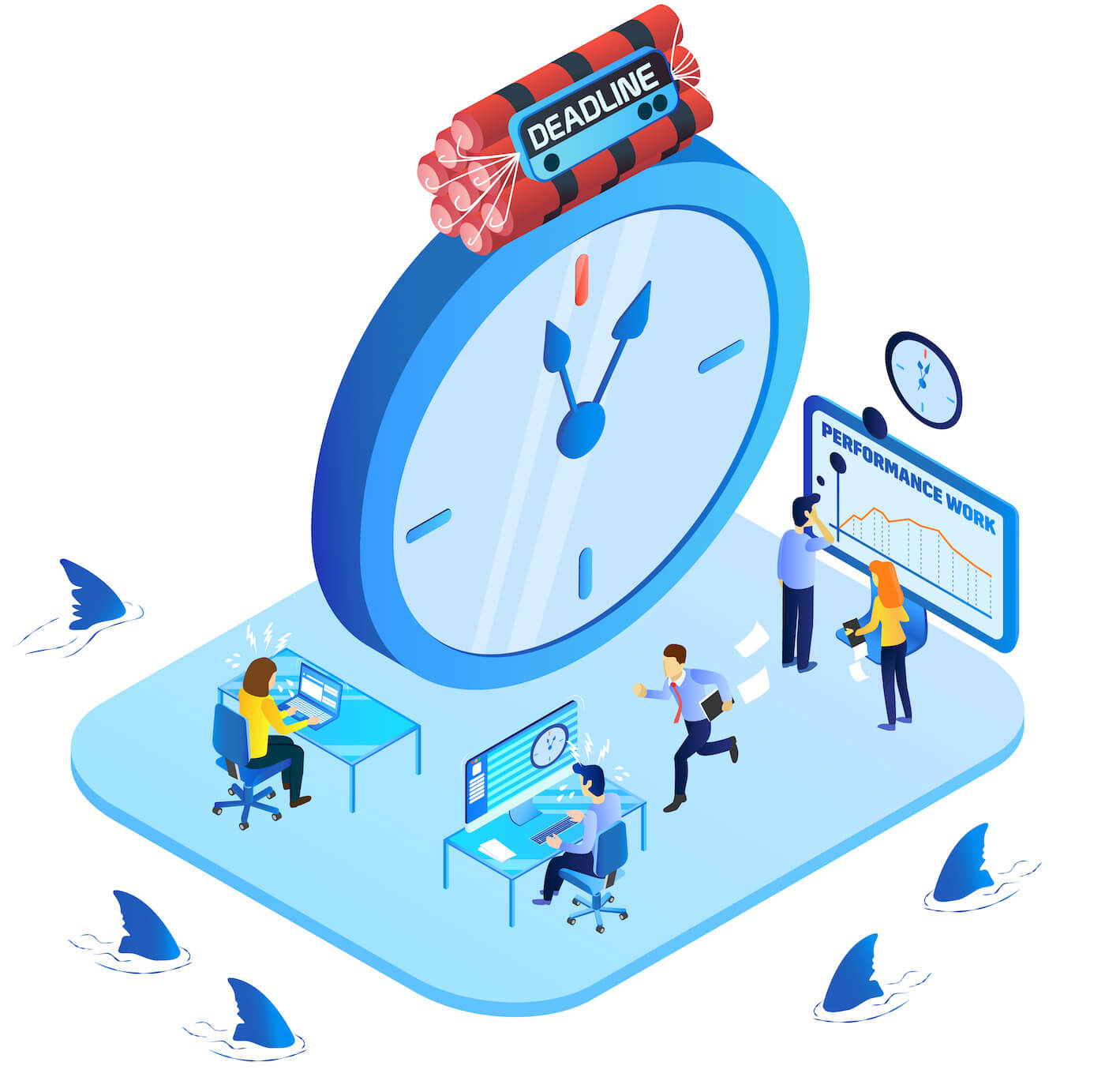What Exactly is Time Theft and How to Stop it
You work hard to grow your businesses and earn revenue. But your “hard-working” employees seem to take advantage of your left and right.
When employees cheat on company time, otherwise known as time theft, it can be challenging to catch!
Sound familiar?
If you’re a manager or business owner struggling with time theft, you’re at the right place. Time tracking software like SoftActivity can help you end this behavior. Here’s exactly what time theft is and how to stop it with SoftActivity.
What Exactly is Time Theft?

As we have mentioned, time theft is time that employees claim as working hours when they are instead working on personal items. By claiming work hours, they are earning income from your company. This is stealing since they aren’t contributing to the work they claimed or proposed to do, costing your company more than it should.
Time theft is different from granting salaried employees leeway for breaks. It’s more common in contract and hourly workers who might continue to “work” while away from their desks or during social hours.
Time theft happens in the office as much as remotely in the work-from-home setting. In both instances, time theft can be caught with time-tracking software and used to support legal action like firing the employee or forcing them to pay the money back in some form.
It can be easier to track time theft with monitoring software that tracks behaviors on work computers. Here are some signs you have time theft if you don’t have tracking software:
- The work completed is not thorough enough, but you don’t know how
- Your remote employee has been unresponsive for too long
- You can see employees stand around too much to get work done
How you handle time theft is up to you. But we’re here to help you navigate this tricky situation.
Most Common Examples of Employee Time Theft
Without time tracking software, employees can get away with time theft. The extent of this depends on the job situation, the location of the employee, and the work being conducted. For example, if you have an employee that regularly travels for work, you’ll see a lot of flexibility when it comes to working hours, which is to be expected.
So what does time theft look like? Here are some common examples:
Work-From-Home Employee Away From Their Desk
Work-from-home employees believe they answer to no one else but themselves. Remote employees are still employees and must work while on the clock. Without employee monitoring software, employers can’t see when they are away from their desks, which is ultimately time theft if done while on company time.
In-office Employee Regularly Chatting on Break
Your office employees might be chatting too much or on break. If you see many of your employees gossiping around the water cooler, that is time theft. If you see this, take note of who is there and how often they visit the break spot or take the time. Time tracking software will be able to catch the break frequency, too, and calculate how much time was spent not working.
Traveling Employee Submitting Full-time Hours and Part-time Work
It can be difficult to catch time theft with traveling employees because they often need to be unresponsive or drive. You can identify time theft through work submitted.
If you can see only part-time work is submitted, they likely committed time theft. Additionally, time tracking software with GPS can tell you where your employees are so you can see if they are mobile or regularly parking their trucks and scrolling social media.
Contract Workers Scrolling Social Media Instead of Filing Reports
If your contract workers need to pay more attention to their duties and instead scroll social media, this is time theft. While your contract workers aren’t exactly employees, they still have to adhere to working hours, and you can hold them accountable.
Staff Obsessing Over a Customer Issue Instead of Being Productive
Okay, your staff is still working, but you hear them repeatedly talking about a customer issue instead of being productive and getting things done. Customer issues are important, but there should be a cap on how much time it takes out of your day. This will vary from business to business, but pay attention to these sneaky time theft acts, which seem like work when in reality is time stealing.
Remote Employee Regularly Calls Out On Meetings
Another example of time theft is when a remote employee fails to call into meetings. This time theft takes away your team’s productivity because they must regularly contribute to team meetings. If your remote employee calls out of meetings, but this is not reflected in their timesheets, this is time theft.
Identify Signs of Time Theft With These Time Tracking Software Features

No matter which time theft examples you are threatened with, time tracking software can help by highlighting certain behaviors and alerting management.
Here are the key features to use in time tracking software to stop time theft:
Time Spent on Application
Employee monitoring software tracks how long the computer’s user spends on a given application. Applications are things like your Chrome browser, Microsoft Word, and Slack. This software reads where the cursor is used and where keystrokes occur to calculate the total time spent on that application.
Employees may need to use these applications, but there are reasonable limits. If your team is working on a Call for Proposal in Microsoft Word, set time tracking weekly limits to monitor how frequently they work overtime on this proposal. If it falls under that limit, then you might not have time theft. But, if you find they are spending hours over, this may signal that they aren’t working as they should.
Time Spent on Website
Like tracking time on applications, employee monitoring software can also track the time spent on a URL. That’s right – you can see which websites your employees browse while on company time. Websites like Facebook and Twitter may be relevant for a marketing team, but they certainly aren’t for your customer support department. Additionally, you can see how long they’ve spent on each of those sites so that you can properly address this time theft.
Communication Tracking Tools
Communication tracking tools like Microsoft messenger can be useful for communicating with team members. However, it is unlikely that your team will need to clock hours on these software tools. Most likely, your team is stealing your time by chatting online with other team members. Luckily, your time tracking software will capture time spent on those tools and even the messages sent so you can see if they are working.
Unresponsive Time
In addition to active behaviors, monitoring software also takes notes and calculates inactive behaviors. This is why tying your mouse to a fan became popular as a way of “moving the mouse,” which tricked the system into believing that the user was active. Regardless, if you see any inactive hours, your team is off the computer and doing something else. They needed to modify the hours if their unresponsive time was unrelated to work.
Task Tracking
Monitoring software is useful for tracking tasks in projects and project status. By asking your employees to record time spent on tasks, you can gain insight into how long a specific task will take and whether it took too long.
Screen Recording
Screen recording is an advanced time tracking feature that many employees use for both their in-office and remote employees. The screen recorder does not use the webcam but instead takes a recording or screenshots of the user’s monitor so you can see exactly what they are working on. This can give you the most accurate update on employee time.
Keystroke Logging
Keystroke logging is another advanced feature that records all of the keystrokes a user hits during working hours. You can read this data to see what they are working on when they are tracking time to see if it lines up. Who knows – they could be deceptive and steal time even if they look like they are working.
Identifying Signs of Time Theft in Time Tracking Software
Luckily, stopping time theft is far easier with time tracking software. Your team can use the numerous time theft features to identify and stop time theft in its tracks.
Time tracking software like SoftActivity should be installed and configured for tracking possible time theft. Monitoring software can be used for remote teams, in-house teams, secretly, from a single console, or individually downloaded on personal computers for work purposes. Activate features like time spent on applications, time spent on websites, wasted time reports, and screen recording to catch time theft.
To identify signs of time theft, simply activate the features listed and monitor the software during work hours. You will also want to audit the time theft data after work hours to understand the time better. Most time tracking software will also generate reports and send alerts so you can stay on track of certain events, like too much time spent on Facebook, and stop it right then.
Over time, you’ll recognize the obvious signs of time theft through your time tracking software metrics. Consult resources to set up the following baselines:
- How much time should be spent on social media sites?
- How much time should be spent on work-related websites?
- Categorize your work tasks to understand what types of activities are being conducted. Is it admin? Is it client-facing work? Is it work that is not related to the employees’ job description?
- Set up a policy for how often a wasted time report comes in.
Your baseline metrics will vary as your company evolves and as you learn how to identify and stop the signs of time theft in your company. Luckily, with SoftActivity on your side, you’ll easily be able to install and configure the time theft features, so you don’t fall victim to employee time theft.
By SoftActivity Team.